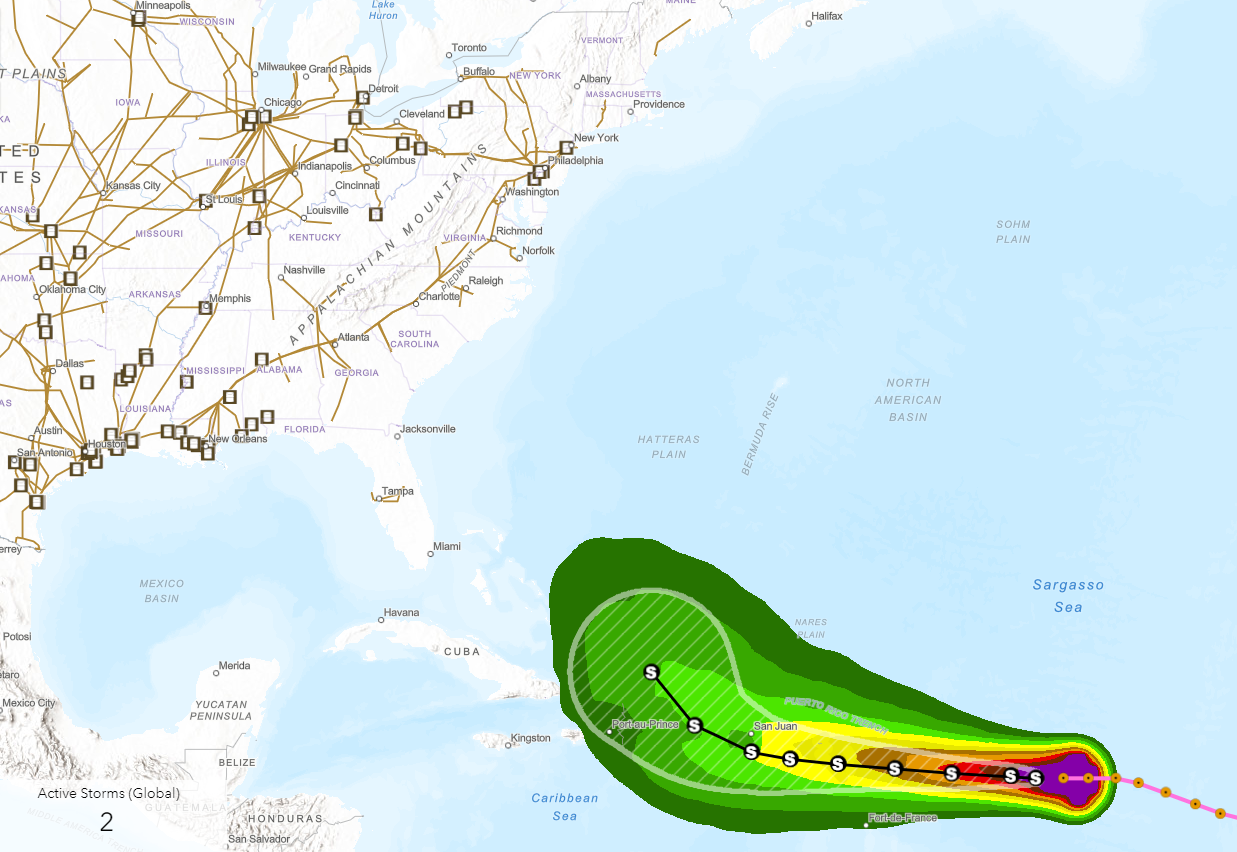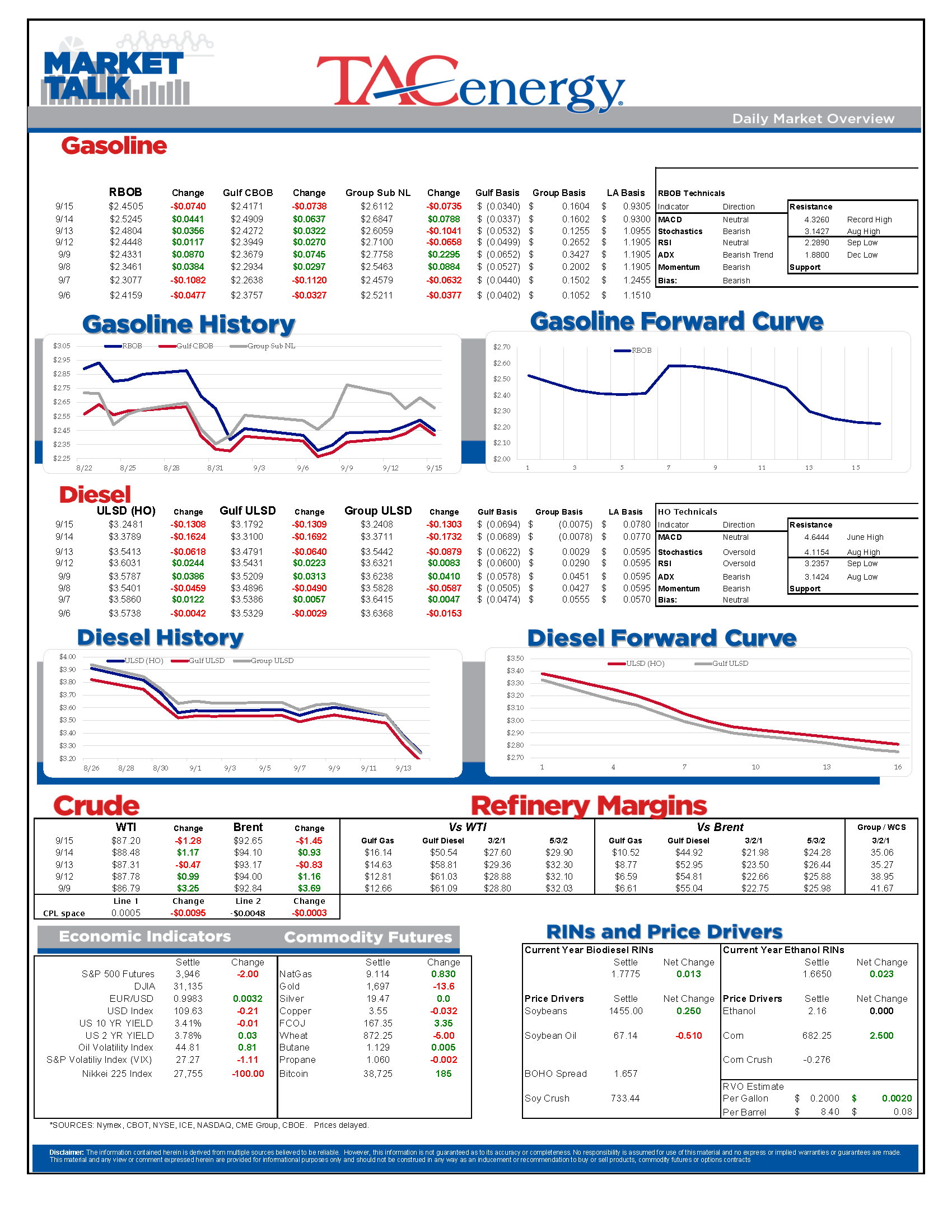Diesel Prices Have Dropped 45 Cents From Monday’s High

Diesel prices have dropped 45 cents from Monday’s high as demand concerns both domestically and globally are putting heavy downward pressure on prices, and RBOB and WTI are now joining in on the selling after resisting the pull lower Wednesday. ULSD futures are still more than 10 cents higher than their August lows, but look like they could make a run at those levels soon, with a move below $3 likely if that support breaks.
Some suppliers will be breathing easier this morning after reports that a “tentative deal” was reached to avert a nationwide railroad strike that could have created chaos in numerous commodity markets. Ethanol supplies in particular were troubling many suppliers this week as it could have left many terminals with plenty of gasoline in the tank, and yet no E10 available to sell at the rack, in addition to numerous concerns about Biodiesel and DEF supplies nationwide. Watch the price reaction in the grain, renewables and RIN markets today to see whether or not the market believes this deal will actually make it to reality.
The European Commission proposed an emergency energy market intervention plan Wednesday that includes mandatory reductions in demand for member countries, a cap on electricity prices from renewable, nuclear and coal sources, and a “temporary solidarity contribution on excess profits” for oil and gas sectors that somewhat like a Soviet-style solution to the Russian energy problem. The plan did not include a price cap on Russian energy purchases as had been previously proposed.
The IEA highlighted how Chinese lockdowns are leading a slump in global energy demand, but noted that demand is still growing, just not as fast as it was expected to this year. The monthly report also noted that EU embargos on Russian oil have not yet come into effect, and will do so just in time for the coordinated SPR releases to come to an end, leaving markets susceptible to new price spikes. The report highlights the specific concerns around distillate supplies, as Europe still does not have a solution for the 600mbday of Russian diesel it will stop importing this winter, and refinery capacity constraints severely limit their options.
Wednesday’s DOE report showed a large build in US Commercial crude inventories, but total oil stocks including the SPR declined, proving the IEA’s point that supplies may not look so strong once the record releases come to an end in two months. US crude oil output has stagnated over the past two months as labor logistical challenges continue to limit the growth in production. The report estimated that US diesel demand dropped by 13% to its lowest level of the year last week, which certainly isn’t helping encourage any buyers to step in at these lower levels, even though most PADDs have inventories well below normal levels.
Want to understand why California gasoline prices surged by more than $1/gallon last week? Take a look at the PADD 5 gasoline stocks chart below. Also note the huge decline in Midwestern (PADD 2) gasoline stocks the past 2 weeks as regional refiners have struggled to stay online, and shows how important the RVP waivers issues after BP’s refinery went offline were to avoid a price spike like we’ve seen on the West Coast.
Tropical storm Fiona was named overnight, and most models continue to suggest the storm will turn north by Monday and not threaten the Gulf of Mexico, making it a non-event for energy supplies. Most models keep this storm moving away from the East Coast as it moves north, but a few suggest that a landfall near the Carolinas is possible next week.
Latest Posts
Week 17 - US DOE Inventory Recap
The Energy Complex Is Trading Modestly Lower So Far This Morning With WTI Crude Oil Futures Leading The Way
Energy Futures Are Drifting Quietly Higher This Morning
Refined Products Holding Close To Break Even While Oil Prices Are Losing Just Under 1%
Social Media
News & Views
View All
Week 17 - US DOE Inventory Recap

The Energy Complex Is Trading Modestly Lower So Far This Morning With WTI Crude Oil Futures Leading The Way
The energy complex is trading modestly lower so far this morning with WTI crude oil futures leading the way, exchanging hands $1.50 per barrel lower (-1.9%) than Tuesday’s settlement price. Gasoline and diesel futures are following suit, dropping .0390 and .0280 per gallon, respectively.
A surprise crude oil build (one that doesn’t include any changes to the SPR) as reported by the American Petroleum Institute late Tuesday is taking credit for the bearish trading seen this morning. The Institute estimated an increase in crude inventories of ~5 million barrels and drop in both refined product stocks of 1.5-2.2 million barrels for the week ending April 26. The Department of Energy’s official report is due out at it’s regular time (9:30 CDT) this morning.
The Senate Budget Committee is scheduled to hold a hearing at 9:00 AM EST this morning regarding a years-long probe into climate change messaging from big oil companies. Following a 3-year investigation, Senate and House Democrats released their final report yesterday alleging major oil companies have internally recognized the impacts of fossil fuels on the climate since as far back as the 1960s, while privately lobbying against climate legislation and publicly presenting a narrative that undermines a connection between the two. Whether this will have a tangible effect on policy or is just the latest announcement in an election-yeardeluge is yet to be seen.
Speaking of deluge, another drone attack was launched against Russian infrastructure earlier this morning, causing an explosion and subsequent fire at Rosneft’s Ryazan refinery. While likely a response to the five killed from Russian missile strikes in Odesa and Kharkiv, Kyiv has yet to officially claim responsibility for the attack that successfully struck state infrastructure just 130 miles from Moscow.
The crude oil bears are on a tear this past week, blowing past WTI’s 5 and 10 day moving averages on Monday and opening below it’s 50-day MA this morning. The $80 level is likely a key resistance level, below which the path is open for the American oil benchmark to drop to the $75 level in short order.
Click here to download a PDF of today's TACenergy Market Talk.

Energy Futures Are Drifting Quietly Higher This Morning
Energy futures are drifting quietly higher this morning as a new round of hostage negotiations between Israel and Hamas seem to show relative promise. It seems the market is focusing on the prospect of cooler heads prevailing, rather than the pervasive rocket/drone exchanges, the latest of which took place over Israel’s northern border.
A warmer-than-expected winter depressed diesel demand and, likewise, distillate refinery margins, which has dropped to its lowest level since the beginning of 2022. The ULSD forward curve has shifted into contango (carry) over the past month as traders seek to store their diesel inventories and hope for a pickup in demand, domestic or otherwise.
The DOE announced it had continued rebuilding it’s Strategic Petroleum Reserve this month, noting the addition of 2.3 million barrels of crude so far in April. Depending on what the private sector reported for last week, Wednesday’s DOE report may put current national crude oil inventories (include those of the SPR) above the year’s previous levels, something we haven’t seen since April of 2022, two months after Ukraine war began.
The latest in the Dangote Refinery Saga: Credit stall-out, rising oil prices, and currency exchange.
Click here to download a PDF of today's TACenergy Market Talk.

